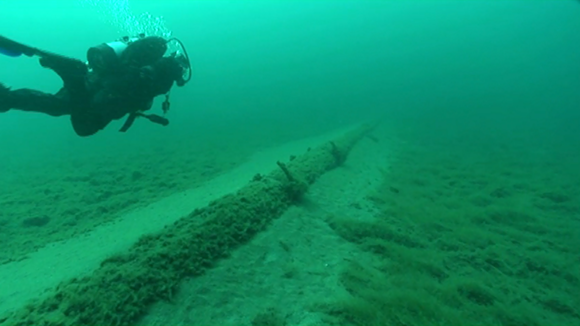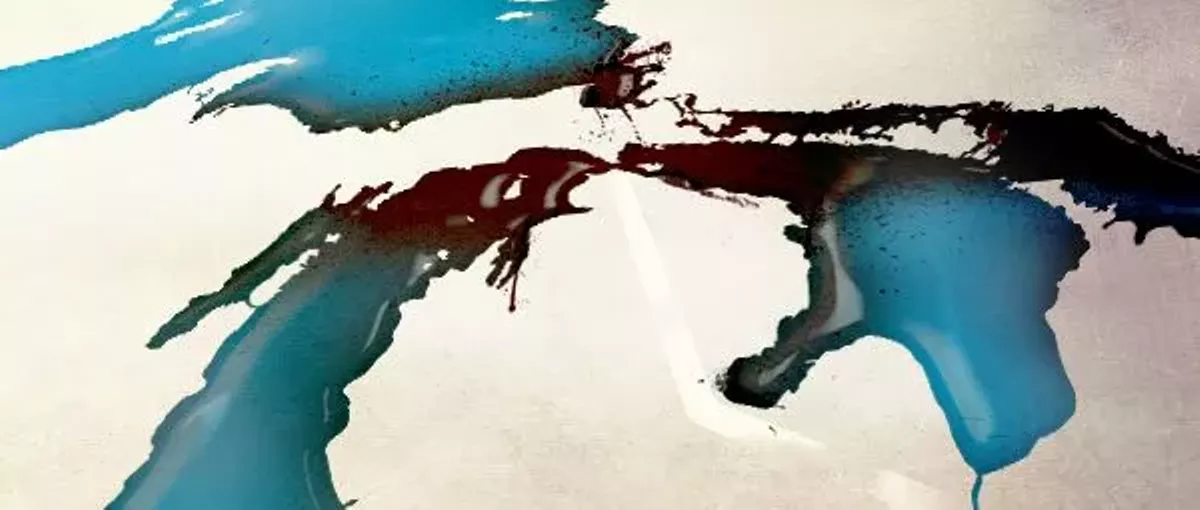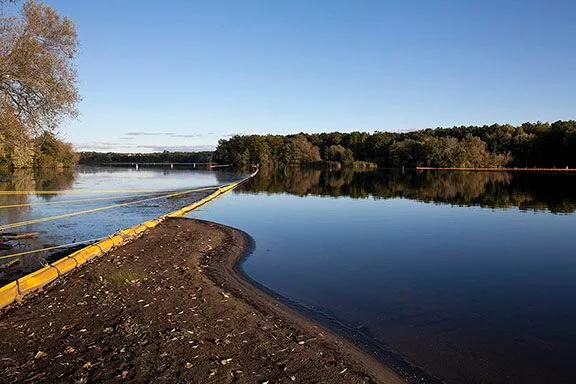When President Barack Obama officially rejected the proposed Keystone XL Pipeline in September, it marked the end of a seven-year battle that even he admitted had become largely symbolic. The issue — the proposed construction of a pipeline owned by oil giant TransCanada Corp., which would move crude oil from Alberta’s oil sands to refineries on Texas’ gulf coast — had spiraled into a partisan controversy pitting environmentalists against industry. In his speech announcing the rejection, Obama summed up the issue as neither “a silver bullet for the economy, as was promised by some, nor the express lane to climate disaster proclaimed by others.”
In a way, it's strange that such a fuss was made over Keystone XL in the first place. The pipeline would've been far from the only one in the U.S. In fact, there are already 2.5 million miles of pipelines coursing through the country — filled with oil, natural gas, and other products. Even without Keystone XL, the U.S. Energy Information Administration announced that in 2014, U.S. oil production increased from 1.2 million barrels per day to 8.7 million barrels — the largest increase in more than a century. And there are other proposals for more pipelines on the way.
But in the years that Washington spent debating Keystone, some environmentalists have instead turned their concerns to one of these existing pipelines, arguing it could pose a very real threat to one of North America's most treasured and important natural resources: the Great Lakes.
When first completed in 1953, what is now known as Line 5 — now owned by another Canadian giant, Enbridge, Inc. — was a feat of modern engineering. Up until that point, oil from Alberta's Athabasca oil sands was transported eastward to refineries in Ontario through an extensive pipeline system. But the oil had to be transferred onto barges to cross the Great Lakes, which were halted when the lakes froze over in the winter.
That's when Enbridge's predecessor, the Lakehead Pipe Line Co., figured it could transport the oil under the Straits of Mackinac. They split Line 5's 30-inch pipeline into two 20-inch diameter pipelines, laid down along the bottom of the straits about 1,000 feet apart and reaching depths of over 200 feet. When it was completed, the totality of Line 5 (from Superior, Wis., to Sarnia, Ontario) was the largest pipeline in the world, and the 4-mile-long straits portion was five times longer than had ever been built before.
At the time, Imperial Oil Co., the Lakehead Pipe Co.'s parent company, described the straits pipeline as "probably the most difficult project ever undertaken by pipeline engineers." Its engineers boasted that the structure would safely last 50 years.
That, of course, was 62 years ago.
A mucky track record
Today, Line 5 transports 540,000 barrels, or 22.7 million gallons, of light crude oil and natural gas liquids per day. That's roughly the equivalent of 688 railroad tank cars or 2,512 tanker trucks. In fact, it's a recent increase in capacity — in 2013, Enbridge upgraded its pumping systems to increase the rate by 50,000 barrels, up from 490,000 barrels per day.
But while pipelines are regarded as safer and more efficient than transporting oil using barges or railroad, the system is not immune to spills. And Enbridge has had many spills already. Between 1999 and 2010, Enbridge was responsible for more than 800.
In fact, Enbridge can lay claim to another world record. On July, 25, 2010, Line 6B — another pipeline, which routes oil from a Chicago-area node south around Lake Michigan and toward Sarnia — ruptured near Marshall, Mich. The spill resulted in nearly 20,000 barrels — 840,000 gallons — of heavy crude oil flowing into Talmadge Creek, which made its way into the Kalamazoo River.
It was the largest inland oil spill in U.S. history. And as far as PR disasters go, the timing couldn't have been worse. Enbridge's accident followed on the heels of the largest accidental marine oil spill of all time, as response crews were still trying to cap BP's disastrous Deepwater Horizon oil spill, which released more than 4.9 million barrels into the Gulf of Mexico over three months.
An investigation revealed that it took Enbridge more than 18 hours to learn of the Kalamazoo River spill. And while alarms did sound, the pipeline operators thought they meant there was a block in the pipeline, and increased the pressure to try and clear the pipes — pumping even more oil into the river.
The mess polluted 38 miles of the Kalamazoo River and 4,435 acres of adjacent shoreline habitats, resulting in a five-year cleanup. To date, Enbridge has paid an estimated $1.2 billion to clean up the spill, in addition to more than $80 million in state and federal fines.
Across the country, there's been more oil spilled. In 2011, an ExxonMobil pipeline dumped 1,000 barrels into the Yellowstone River in Montana. In 2013, another ExxonMobil pipeline burst in Arkansas, releasing 3,190 barrels of oil. In 2015, a pipeline owned by Plains All American Pipeline LP burst, releasing 2,500 barrels of oil off the coast of Santa Barbara, Calif. It was the largest coast spill in the state in a quarter century.
'Unbelievably atypical'
The Great Lakes are home to 20 percent of the world's freshwater and 90 percent of the freshwater in the U.S., providing drinking water for 30 million people in the U.S. and Canada. Additionally, the lakes host wildlife reserves, fisheries, and recreational boating. In the straits, Mackinac Island is a popular tourist draw and resort destination.
Technically, Lakes Michigan and Huron are one body of water, divided only by the straits. And that's what has some experts worried.
Following the Line 6B disaster, the National Wildlife Federation (NWF) in 2012 released "Sunken Hazard: Aging oil pipelines beneath the Straits of Mackinac an ever-present threat to the Great Lakes." The 16-page report called for immediate action to address Line 5. "History has proven that agencies and pipeline operators continue to favor a reactionary approach to pipeline oversight," the report reads. "Unless action is taken, an oil spill in the Straits of Mackinac isn't a question of if — it's a question of when."
It's a cause that the NWF has continued to address. In 2013, the organization commissioned a dive to take a firsthand look at the pipelines. The underwater photos they released showed large expanses of the pipelines were unsupported by any anchoring structures — a possible breach of the Lakehead Pipe Line Co.'s original 1953 Easement with the state of Michigan, which mandated that "the maximum span or length of pipe unsupported shall not exceed seventy-five (75) feet." The dive also showed that the pipes were almost entirely encrusted with exotic zebra mussels and quagga mussels that didn't exist in the Great Lakes until the 1980s, which have since rapidly multiplied due to their lack of natural predators.

The NWF also commissioned a study that would create a computer simulation of what a spill in the straits would look like. The results of the study, released in 2014, sounded more alarms among environmentalists.
"I stand by my quote [at the time] — I can't think of a worse place to have an oil spill in the Great Lakes in terms of how fast it would spread, how far it would, and how unpredictably it would spread," says David Schwab, the University of Michigan oceanographer and hydrodynamics expert who was tapped by the NWF to create the simulation.
Schwab calls the currents in the straits "unbelievably atypical" in that they oscillate in direction — from Lake Michigan to Huron, and vice versa — on a cycle of two to three days. The lakes, he says, respond to the local weather patterns, and notes that weather as far away as Chicago and Port Huron can affect the flow through the straits. And Schwab says when that flow is at its peak, the amount of water can be up to 10 to 20 times what goes over Niagara Falls, at speeds as strong as those found in the Detroit River.
Schwab released a series of animations along with the study, illustrating the flow of spilled oil. While each video varies depending on conditions, all show the same sort of churning motion between the two lakes, which disperses particles far and wide in every direction.
"Anything that was released into the water could move into Lake Huron or Lake Michigan with almost equal probability," he says.
The simulations were largely based on two scenarios: one 20-day period where the water in the straits was initially moving from Lake Michigan to Lake Huron, and a second scenario using a 20-day period where the water was initially moving from Huron to Michigan. Within those scenarios, Schwab simulated leaks from the north side, the center, and the south side of the straits. In every case Schwab found that materials could be moved up to 50 miles.
Schwab used a hypothetical 12-hour release period, but he says it wouldn't matter how long the leak occurred. "The point of it was to show how much area could potentially be impacted by a spill," he says. "And that really doesn't depend on how long the spill was. It can travel just as far if it was released for a little bit of time — but the longer the spill, probably the more widespread the impact would be."
Schwab says the study represents a small sampling of possible outcomes — ideally, hundreds of simulations would be tested with different variables. But it's not just a matter of simply running a computer program: Such a study would need scientists to analyze the data as well.
One aspect that Schwab says does need more studying is what the currents look like in the winter, when the lakes are covered in a sheet of ice. He says researchers have not had any measures of currents under the thick sheets of ice until this year, and those simulations are currently underway. "What we'd expect is that if Lake Huron and Lake Michigan are open, it doesn't matter if the straits are frozen," he says. "You'll still get the oscillating flow."
Other conditions that could hinder an oil spill recovery are the wave heights. According to recent Detroit Free Press report, conditions of 3- to 5-foot waves could delay a response for hours or even days — conditions that are by no means rare in the straits.
New information making the case against Line 5's precarious location seems to be released in a trickle as scientists and activists further study the Great Lakes.
Slippery data
Metro Times submitted a Freedom of Information Act request to Michigan Department of Environmental Quality for documents pertaining to the safety of Line 5. It sought information regarding the integrity of the structure or inspection results — anything that could offer a look below the surface of the straits.
Instead, the documents revealed a potential problem on land.
One of the documents obtained included a report on the North Straits Pumping Station in St. Ignace, located just off the coast of the straits, where Line 5 splits off into the two straits pipelines. According to the report, Enbridge discovered contaminated soil at the pumping station while making upgrades in 2011.
The company wound up removing 361.6 tons of contaminated soil, the result of what the report called "historical releases of crude oil from the Enbridge pipeline system during routine maintenance activities." While removing groundwater from the site, Enbridge noticed a strong petroleum odor and installed a mechanical treatment system. Later, in 2013, Enbridge installed monitoring wells on the site, which detected low levels of volatile organic compounds in the groundwater.
Enbridge submitted an excavation report and a groundwater report to MDEQ, summarizing their activities and stating that no additional remedial activities were necessary. Concerned, MDEQ's Remediation and Redevelopment Division sent Enbridge a letter in Jan. 5 requesting further evaluation regarding the extent and origin of the contamination.
According to an additional report, as of September the site meets MDEQ's cleanup criteria, and Enbridge is sampling the water quarterly. When reached for comment, Scott Schaefer, a project manager for MDEQ, says the "historical releases" were most likely the result of many years of minor spills and not some singular undocumented event.
"It's been a pumping station for many years," he says. "According to their personnel, they thought that over the years as they were accessing that thing that there would have been some minor spills."
He says the St. Ignace effort is an example of Enbridge cleaning up its act following the Kalamazoo River disaster. "Five years ago, I don't think 5 percent of the people in Michigan knew that there was a pipeline that ran under the straits," he says. "Now, there's probably only 5 percent of the people who don't know that. As a company they've matured more environmentally. They're aware of some of their responsibilities, and taking it more seriously."
Why Enbridge didn't identify or address soil contaminated from "historical releases" as a potential problem until 2011 is another question. But Schaefer thinks what's important is that Enbridge did something. "From my assessment, they're trying to do things right," he says. "They know they're in the public's eye. They have to be a good corporate citizen now, and they realize that." (The implication that they felt they didn't have to be a good corporate citizen until people started asking questions is troubling, as is the fact the excavation has been previously unreported.)









